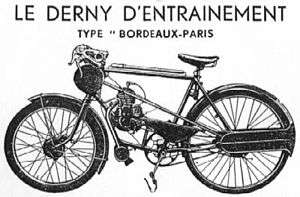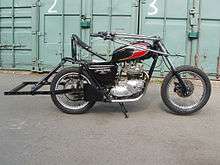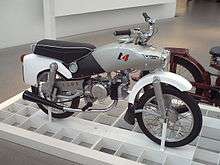Derny



A derny is a motorized bicycle for motor-paced cycling events such as during six-day and Keirin racing and motor-paced road races. It is driven by a 98 cc (6.0 cu in) Zurcher two-stroke engine and by being pedalled through a fixed gear, typically of 70 teeth on the front chainring and 11 on the sprocket on the back wheel. The combination allows for smooth acceleration and slowing, important when the rider taking pace is centimetres from the pacer's shielded back wheel. A coupling between the motor and the back wheel ensures the derny will not stop dead if the motor seizes. Top speed, with rider pedalling, is up to 50 km/h (31 mph), depending on gearing.
The first Derny 'Entraineur' or 'Bordeaux–Paris' models, with their characteristic petrol tank across the handlebars, were built by Roger Derny et Fils of the Avenue de St Mandé, Paris, France in 1938. A fleet of Dernys was maintained for the long-established 'Bordeaux-Paris' road-race and the Derny was used for many other track and road events and for endurance training. Derny also built a touring adaptation called the 'Solo' and tandems and mopeds.
The firm closed in 1957, after an unsuccessful venture with the 'Taon', a Roger Tallon-designed motorcycle. Another company, Service Derny, of Rue Picpus, Paris, serviced and rebuilt machines into the 1970s.
The name derny is now applied to all small cycle-pacing vehicles, regardless of manufacturer. It is used by the Larousse dictionary as a generic term for a small pacing motorcycle used in cycle races. There have been several attempts to copy or improve the original. One, the Burdin, was briefly used, but proved neither durable nor fast enough for repeated high-speed riding on the steep tracks used in six-day racing. Modern machines are made by a small company in Neerpelt, Belgium, and dernys are either new or have the original frames with new 90 cc (5.5 cu in) engines.
The machine has to be bump-started. It can then pace riders up to 90 km/h (56 mph), although races rarely exceed 80 km/h (50 mph)..
The rider sits close to the back in an upright position to provide an envelope of low wind resistance for the cyclist drafting or slipstreaming behind. For most derny races, the cyclist sits in the slipstream for the duration of the event. In keirin races, common in Japan and familiar elsewhere, the derny brings riders up to speed then pulls off the track and the race finishes in a sprint without the pacer.
Some riders train behind a derny on the road.
A small group of semi-professional pacers travels around Europe for the winter six-day season. Most are in their 60s and 70s and some have been pacing for more than 40 years.
In most of its later history, the 560 km (350 mi) Bordeaux–Paris classic road race was motor-paced using dernys from half-distance. Other important races on the road behind dernys have included the Critérium des As in Paris.
See also
External links
| Wikimedia Commons has media related to Derny motorcycles. |